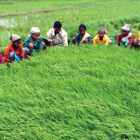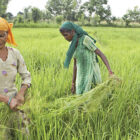The presumptive loss to 50 lakh potato farmers on a very conservative basis was ₹30,000 crore or ₹60,000 per potato farmer.
Farmers are traditionally great raconteurs. My grandfather would talk of his encounter with a farmer sitting by a heap of potatoes in the middle of the night. Asked what compelled him to sit by his potatoes when there were no buyers, his astonishing reply was that he was, in fact, keeping a watch to deter anyone from dumping unsold spuds on his field. This 40-year-old episode had a rerun recently when farmers dumped their unsold produce in front of the home and office of the Uttar Pradesh Chief Minister, Yogi Adityanath, in Lucknow.
The genesis of the potato crises in Lucknow, however, is more recent. In June 2014, soon after the BJP won a stunning mandate in the general elections, one of the first acts of the union government was to rein in the price of potatoes (‘Making a hash of it’, IE, July 5, 2014) by imposing a minimum export price (MEP). This was followed by bringing potatoes under the Essential Commodities Act (ECA) and permission for duty-free imports even though the imports carried the risk of new diseases. Farmers were harassed and cold stores raided.
The euphoria of the electoral victory drowned out the farmer’s sorrow. Farmers took home meagre profits, substantially less than they could have easily made. The presumptive loss to 50 lakh potato farmers on a very conservative basis was ₹30,000 crore or (total production 42 million tonnes X ₹7/kg, the subdued price) amounting to ₹60,000 per potato farmer. Profits from the previous harvest usually determine the acreage under sowing for the next season. Consequently, in the following year, India had a bumper crop of 48 million tonnes of potato in 2015 and prices crashed to ₹2.75/kg. The government ignored the plight of farmers, who subsequently failed to even recover the cost of sowing.
2016 was a normal crop year in India, with 44 million tonnes of potato production. Without credible data, fearing inflation, the government overreacted and again imposed an MEP. Without access to international markets, the prices faltered. Unfortunately, demonetisation in November that year made matters worse. The presumptive loss of ₹22,000 crore (₹5/kg) was incurred by farmers, amounting to an average loss of ₹44,000 per potato farmer for year 2016 alone. India’s export restrictions were a bonanza for farmers in Pakistan and Bangladesh. Importers seek reliable business partners and India has become an unreliable supplier due to arbitrary policy decisions. Indian produce now sells at a substantial discount compared to those of its neighbours’.
In 2017, due to the relatively firmer prices of 2016, boosted by good weather, farmers produced 48 million tonnes of potato and prices literally crashed through the basement. When, even after 10 months of storage, prices were hovering between 50 paisa to ₹2/kg and farmers completely lost hope. The cost of growing potatoes being ₹6.50/kg and the additional cost of storage being ₹2.50/kg, it became unfeasible to even reclaim stocks from cold storages and potatoes were strewn in Lucknow and elsewhere.
Do the farmers’ math. In two of the four years of the Modi government, when an opportunity arose to double farm incomes, the government’s inflation targeting strategy kicked in and each potato farmer lost approximately ₹1,04,000. The loss incurred by a farmer in just two crop seasons is more than the debt waiver announced by the government of Uttar Pradesh. There is no denying that controlling food inflation has to be a priority. Even for a potato farmer, with a vested interest in the issue, this experience provides insight into government mindset.
The potato farmer’s demand is fair and simple: Should the government intervene to subdue potato prices in a bad crop year, it is morally bound to give a minimum support price of ₹9/kg in excess production year. Logically, a farmer who is allowed to make money in one year, would be better prepared to bear the losses on the farm in the next. If not, the farmer gets into a perpetual debt cycle and is compelled to seek “financial sops”. Consequently, most farmer organisations are content to limiting themselves to what the farmer understands — “farm loan waiver” and venture no further into the policymaking quagmire.
In 2018, the planting is lower by a mere five per cent and potato prices are expected to be remunerative. The historical data, however, indicates that a short-sighted government may respond by imposing MEP/ECA. The solutions to the farm crises are not limited to budget allocations but rooted in a system where interventions to control food inflation are not harmonised with crop-price compensation. As far as the farmer livelihoods are concerned, state governments and the Ministry of Agriculture & Farmer Welfare are becoming less relevant, as decisions of the Ministry of Food, Public Distribution & Consumer Affairs are demolishing the prime minister’s grand plan for doubling farmer incomes.
Farmers are a demoralised lot. The promised “sab ka saath sab ka vikas” rings hollow, because its starkly evident that the government has decided to focus on the urban vote bank as a part of the strategy to win the parliamentary elections in 2019. About 50 per cent of the population is financially dependent on agriculture directly but religious, caste and ever-changing narratives divide farmers across villages to the extent that farmers are not considered a political force to be reckoned with any more. The opposition is in an equally sad state of disarray, without a farmer face to galvanise the community. Nevertheless, farmers could change fortunes in the Rajasthan and Madhya Pradesh assembly elections, allowing the opposition to bask in the farmers’ misery.




